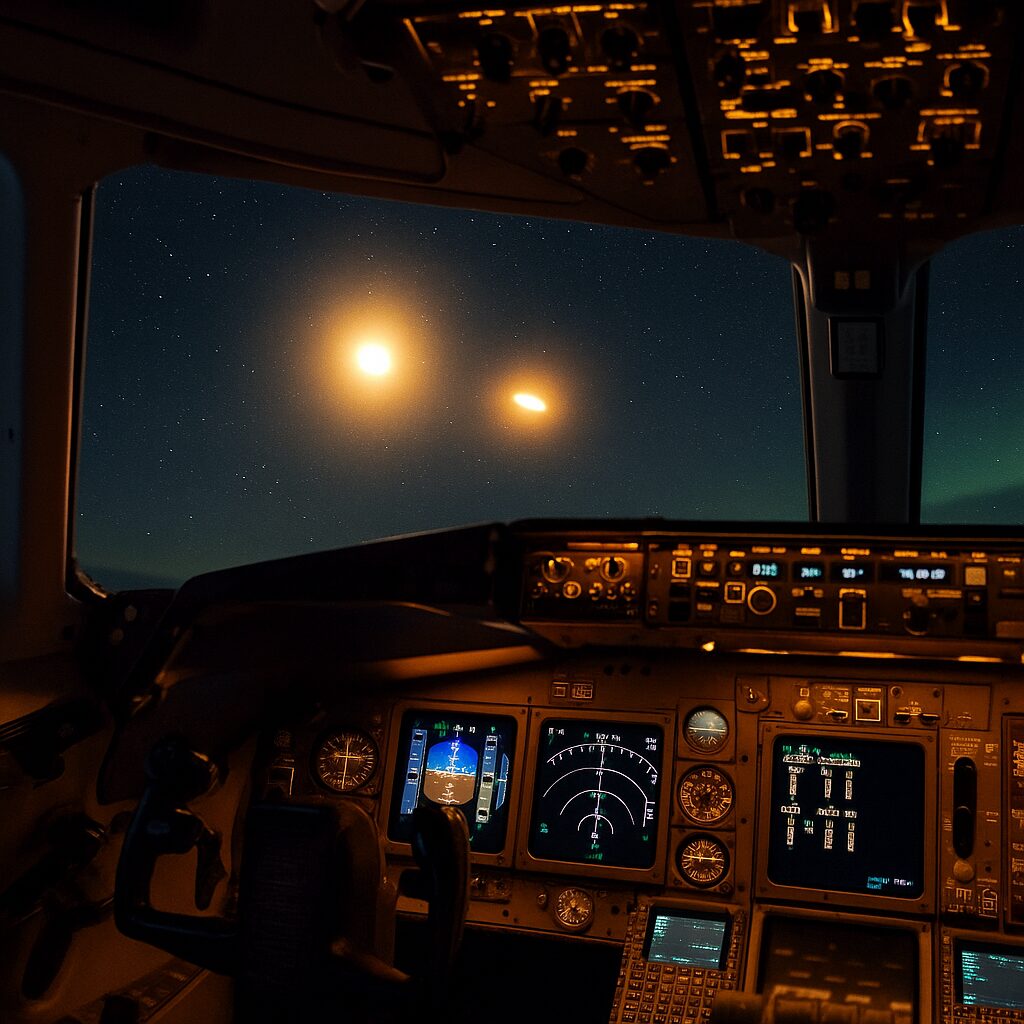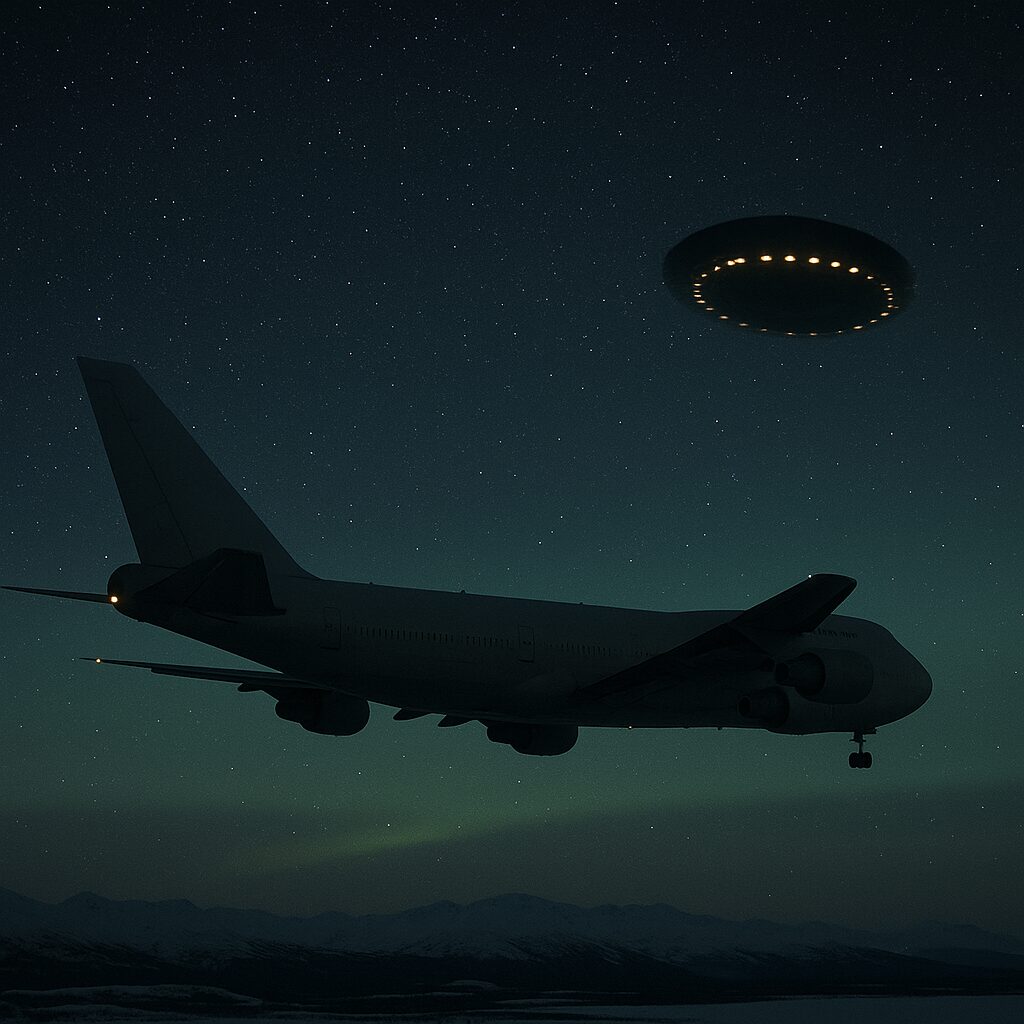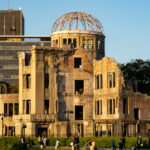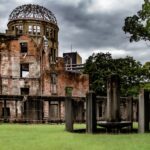Japan Air Lines Flight 1628

Japan Air Lines Flight 1628
The 1986 Alaska UFO Encounter (In‑Depth Guide)
Executive Summary
On the evening of November 17, 1986 (Alaska local time), Japan Air Lines Flight 1628, a Boeing 747‑200F cargo flight, reported multiple unidentified aerial phenomena (UAP) over eastern/central Alaska while en route to Anchorage on a long‑haul cargo run (Paris → Keflavík → Anchorage → Tokyo). The three‑person crew—led by Captain Kenju (Kenji) Terauchi—described two smaller luminous objects and, later, an enormous dark object with a perimeter of lights that appeared to pace the aircraft for an extended period.
Anchorage Air Route Traffic Control Center (ARTCC) acknowledged the reports, coordinated with military radar near Elmendorf, vectored JAL1628 for separation, and attempted to arrange visual confirmation by other aircraft. Radar returns were intermittent and inconclusive. An investigation by the U.S. Federal Aviation Administration (FAA) followed. To this day, the case remains a touchstone in UAP history because it combined trained eyewitness testimony with ATC tapes and radar data, yet yielded no definitive identification.
Flight, Aircraft, Route, and Crew
- Operator: Japan Air Lines (JAL)
- Flight: JAL 1628 (cargo)
- Aircraft: Boeing 747‑246F (freighter variant of the 747‑200 series)
- Route on the day: CDG (Paris) → KEF (Keflavík, Iceland) → ANC (Anchorage, Alaska) → NRT (Tokyo‑Narita)
- Crew complement: 3 (Captain, First Officer, Flight Engineer).
- Captain: Kenju/Kenji Terauchi (a veteran pilot with thousands of hours on heavy jets).
Terminology note: Contemporary documents use UFO; this article uses UAP (Unidentified Aerial Phenomena) interchangeably with UFO.
Operating Environment on Nov 17, 1986
- Time of day: Night; long winter darkness across interior/eastern Alaska.
- Weather aloft: Generally VMC (visual meteorological conditions) reported by crew; scattered or broken cloud layers below at times; cold, very dry air typical of the Alaskan interior in November.
- Airspace: Within Anchorage ARTCC sectors, with proximity to military airfields/radar facilities (e.g., near Elmendorf AFB and Eielson AFB).
- Other traffic: Civil and military aircraft in the broader region; at least one United Airlines flight and a U.S. Air Force C‑130 were coordinated for possible cross‑checks during the event.
Chronology of the Encounter (Approximate, Alaska Local Time)

Times below reflect the sequence reconstructed from ATC recordings, crew statements, and subsequent summaries. Exact minute‑by‑minute details differ among sources; here we present the common core that appears across official summaries and major press accounts.
- Initial Sighting — Two Luminous Objects
While cruising at high altitude inbound to Anchorage, the crew notices two bright lights ahead‑left at roughly their altitude. The lights appear to maneuver and pace the 747. The cockpit becomes noticeably illuminated during the closest phases, and the Captain later speaks of a sensation of radiant heat or glare. - Contact with Anchorage ARTCC
JAL1628 reports the traffic to Anchorage Center. Controllers query nearby traffic, check primary/secondary radar, and, as a precaution, advise that deviation for separation is approved if needed. Over the next several minutes, controllers intermittently report a weak or transient primary return that might correlate, while at other times no target appears where the crew indicates. - Emergence of a Third, Much Larger Object
The crew then becomes aware of a massive, dark object—variously described as “mothership‑like,” “walnut‑shaped,” or larger than an aircraft carrier”—with a rim or perimeter of lights. It appears aft/left of the 747 and seems to hold station for an extended interval. The Captain later sketches a large elliptical/oval configuration with lights along its periphery. - ATC Vectoring and Cross‑Checks
Anchorage Center vectors JAL1628 away from the reported object(s) and requests a United Airlines flight (and later a USAF C‑130) to attempt visual confirmation. The other crews report no visual contact with anomalous traffic and do not acquire an unusual return on their onboard weather radar. - Intermittent Radar Returns
On ARTCC scopes, controllers occasionally see primary‑only returns (no transponder code) near JAL1628, but these are not persistent and are sometimes attributable to clutter or split‑image effects known to occur in that airspace and geometry. Military radar facilities are consulted; accounts of their returns vary by source and are a central point of later debate. - Descent and Arrival
As JAL1628 continues toward Anchorage and descends for arrival, the anomalous lights/objects no longer appear to accompany the aircraft. The flight lands safely at ANC without incident. Total duration of the crew’s experience—from the first lights to the point where the phenomena are no longer observed—has been characterized in press and summaries as on the order of 30 minutes or more.
What the Crew Reported Seeing — Descriptive Details
- Two small luminous objects: Brilliant, white‑yellowish lights, sometimes with a sense of structured shape or “nozzles”/“panels” when closest; perceived maneuverability inconsistent with distant stars/planets.
- Cockpit illumination: The lights were bright enough, at their closest, to cause noticeable interior glare/illumination.
- Thermal sensation: The Captain described a warmth or heat‑like sensation consistent with intense luminescence, though no temperature anomalies were recorded by instruments.
- The large object: A vast, dark mass with a curving/elliptical outline and a ring of lights; often described metaphorically as “walnut‑shaped” or “like a mothership.” The crew perceived it as pacing the 747 off the left‑aft quarter for a significant stretch.
- Drawings/sketches: The Captain’s later hand‑drawn sketches depict a large, oval structure with lights around the periphery and two smaller objects forward of the aircraft.
Key point: The qualitative aspects—brightness, sense of proximity, and the juxtaposition of “small” and “very large” objects—make the case notable. The quantitative aspects (exact slant range, bearing, angular size) remain uncertain, as is typical for nocturnal, unaided‑eye observations from a moving cockpit.
ATC, Radar, and Inter‑Aircraft Coordination
- Anchorage ARTCC: Maintained radio contact, logged pilot reports, issued vectors, and attempted to obtain radar confirmation. Controllers reported intermittent primary returns near the JAL flight path but could not maintain a solid, continuous track that unambiguously corresponded to the reported object(s).
- Military radar: Facilities in Alaska were consulted; accounts differ on whether their scopes produced a sustained target. In later interviews and presentations, a former FAA official described a radar data review/briefing conducted after the incident; however, those claims have been contested or remain only partially documented in publicly available archives.
- Other aircraft: A United Airlines jet and a USAF C‑130 were both referenced in controller‑pilot exchanges for cross‑check. Neither crew provided a confirming visual or onboard radar acquisition of anomalous traffic.
Bottom line: The radar picture was mixed—not entirely negative (there were moments of possible returns) yet insufficient to provide a conclusive correlation with the crew’s visual narrative.
The FAA Inquiry and Post‑Incident Handling
- Crew interviews and medical/fitness checks found no evidence of alcohol or drug impairment.
- ATC recordings, radar data, and logs were reviewed. The FAA’s overall stance, as reflected in summaries disseminated to the media and in subsequent references, was agnostic: the event was unexplained but did not produce evidence of a safety rule violation or a known intruder aircraft.
- Captain Terauchi’s subsequent career is frequently discussed in secondary sources. Many accounts assert that he was temporarily grounded/reassigned after the publicity and later returned to flight status. Because documentation is sparse and sometimes inconsistent, responsible treatments note this as a widely reported outcome rather than as an established, line‑by‑line personnel record.
Why the Case Endures: Three Pillars
- Professional eyewitnesses: A heavy‑jet crew with extensive experience produced a coherent narrative under ATC oversight.
- Audio/radar record: ATC tapes and scope data exist in some form across agencies and media archives, providing an unusually rich evidentiary trail compared to many UFO reports.
- Duration and complexity: The encounter spanned tens of minutes, included apparent maneuvers, and involved multiple attempted cross‑checks (ATC, military, other aircraft).
Competing Explanations and the Evidence For/Against
1) Astronomical Misidentification (Jupiter, Mars, bright stars)
For:
- Bright planets can appear exceptionally intense in cold, clear, low‑humidity skies; scintillation near the horizon can mimic motion.
- Autokinesis and relative motion illusions in a dark cockpit can create the sense of a light pacing an aircraft.
- The astronomical geometry that night placed bright planets in positions that, on paper, could be roughly consistent with some lines of sight.
Against:
- The crew described episodes of very close proximity (cockpit illumination, heat‑like sensation) that planets cannot produce.
- The reported angular sizes, brightness changes, and relative motion—including apparent station‑keeping with a turning 747—are hard to reconcile with fixed celestial objects.
2) Other Aircraft / Classified Flight Activity
For:
- Alaska in the 1980s hosted intense military activity; training routes and interception exercises could, in principle, bring non‑transponding or emissions‑controlled aircraft into proximity.
- Primary‑only radar returns intermittently near JAL1628 could reflect non‑cooperative traffic (though this is conjectural).
Against:
- No accompanying NOTAMs, intercept reports, or later disclosures have surfaced that match the event profile.
- The size and lighting described for the “large object” greatly exceed known aircraft signatures; other airline/military crews nearby saw nothing.
3) Atmospheric/Optical Phenomena (ice crystals, mirage‑like effects)
For:
- Ice‑crystal reflections, light pillars, and halo phenomena can create striking luminous displays, especially near urban light sources (e.g., Fairbanks) or bright celestial bodies.
Against:
- Optical pillars and halos have distinct geometries tied to the Sun/Moon or ground lights; the crew narrative suggests dynamic, structured objects with relative motion to the aircraft.
4) Radar Artefacts (Clutter, Split‑Image, Multipath)
For:
- Controllers explicitly mentioned possibilities like clutter and split images; certain ranges/azimuths in that sector are prone to multipath and ducting artefacts.
Against:
- Even if some returns were artefacts, that does not fully account for the visual experience described by the crew.
Assessment: None of the hypotheses cleanly explains all reported features. The astronomical and radar‑artefact explanations address parts of the data, but persistent elements—proximity effects, cockpit illumination, and the “large dark object”—remain comparatively resistant to conventional modeling.
Media Coverage and Public Timeline
- Late December 1986: U.S. wire services and newspapers begin publishing ATC‑anchored accounts summarizing the reports and the FAA’s initial handling.
- Early January 1987: Major newspapers (e.g., Los Angeles and Washington dailies) run front‑page or prominent features. Television news magazines follow.
- Subsequent years: The case appears in documentaries, books, and magazines focused on aviation anomalies and UFO research; it also becomes a case study in skeptical literature.
Important: While the press played a key role in amplifying the story, the origin of public awareness traces to aviation reporting and FAA confirmations, not to an unverified bar‑room anecdote.
What We Can Say with Confidence
- A JAL 747‑200F crew reported multiple UAP for a prolonged period over Alaska on Nov 17, 1986.
- Anchorage ARTCC treated the reports seriously, provided vectors, and attempted verification.
- Other aircraft did not obtain confirming visuals or onboard radar hits.
- Ground radar produced mixed and intermittent primary returns insufficient for definitive identification.
- The FAA conducted interviews and data reviews, neither confirming a conventional explanation nor endorsing an extraordinary one.
- The case remains unresolved and is frequently cited due to its quality of witnesses, length, and the presence of ATC/radar records.
Open Questions for Researchers
- Can a comprehensive re‑reduction of raw radar data (if preserved) produce a clearer kinematic picture?
- What astronomical reconstruction (including aircraft headings/turns and exact times) best fits the crew’s first phase (two bright objects) without special pleading?
- Is there a viable physical model for a “large dark mass with a ring of lights” that could arise from parallax, reflections, or atmospheric optics, consistent with reported proximity effects?
- Are there unreleased military logs or NORAD tracks relevant to the time/location window?
Lessons for Today’s UAP Discourse
- Multi‑sensor correlation is crucial: Visuals alone are rarely decisive; combining radar, IR, audio, telemetry, and time‑stamped flight data is essential.
- Human factors matter: Night flying encourages autokinesis, after‑images, and size‑distance illusions; trained crews mitigate but cannot eliminate these.
- Transparent archiving: Long‑term value comes from preserving raw datasets (radar plots, ATC audio, flight data) for future reanalysis with improved tools.
- Agnostic rigor: Neither credulity nor reflex skepticism serves safety; the objective is to identify hazards and expand knowledge.
Frequently Asked Questions (FAQ)
Q1. Was the large object tracked continuously on radar?
A. No. Intermittent primary returns were mentioned, but a sustained, unambiguous radar track correlated to the large object was not established.
Q2. Did nearby airline or military crews see it?
A. No corroborating visual was reported by the United flight or the USAF C‑130 referenced during ATC coordination.
Q3. Did the crew take evasive action?
A. The flight received vectors and had clearance to deviate for separation. The crew maintained safety of flight and proceeded to a normal landing at Anchorage.
Q4. Did the FAA declare a cause?
A. No. The FAA neither identified a conventional cause nor endorsed an extraordinary explanation; the event remains unexplained.
Q5. Is the case considered credible by aviation experts?
A. It is widely regarded as worthy of study due to the crew’s professionalism and the ATC/radar context. Whether it indicates misperception, unknown phenomena, or unrecorded traffic remains debated.
Selected Primary‑Source Materials (for further research)
Titles and document types are provided for orientation. Researchers can locate these through library databases, FOIA repositories, newspaper archives, or aviation collections.
- Anchorage ARTCC controller–pilot audio transcripts and facility logs (Nov–Dec 1986).
- FAA internal memoranda and post‑event summary reports regarding JAL1628.
- Major U.S. newspapers and wire services (late Dec 1986–Jan 1987) describing the encounter and FAA statements.
- Pilot interviews with Captain Kenju Terauchi in early 1987.
- Skeptical analyses published in the late 1980s–1990s outlining astronomical and radar‑artefact hypotheses.
- Later presentations by former FAA personnel concerning radar data reviews/briefings related to the case.
Conclusion
The JAL 1628 case endures not because it proves something extraordinary, but because it refuses to be reduced to something ordinary without remainder. A veteran crew observed multiple, structured lights and a vast, dark object over Alaska, ATC took the reports seriously, and radar data offered just enough to keep the mystery alive—yet not enough to settle it. Until comprehensive raw datasets are recovered and re‑analyzed—or an independent event provides a stronger multi‑sensor match—the encounter stands as a measured, unresolved datum in the annals of aviation and UAP history.










